Manufacturers Offer More Flexibility, Child Care to Workers

How can companies provide workers with the flexibility and support they seek? This question has become increasingly pressing for manufacturers as they compete in a tight labor market, and many have come up with their own innovative answers.
Recently, the Manufacturing Institute—the workforce development and education partner of the NAM—hosted a panel with leaders from Toyota, Cornerstone Building Brands, Pioneer Service Inc. and 3M about the child care benefits they offer and how they are reconceiving flexibility.
Child care: The companies provide a variety of different services to their team members, according to the speakers, to account for varying needs.
- Toyota offers a comprehensive suite of services that includes onsite child care at select locations, emergency backup care, tutoring and counseling services.
Flexible options: Though these manufacturers run complex operations, they are increasingly empowering workers to shape their own days. For example:
- At Cornerstone, office workers come into the office one day a week on the same day. Hourly workers are also offered flexibility—they can take part-time shifts in nonstandard times.
- 3M’s “Work Your Way” program is a trust-based system that allows nonproduction employees to designate the way they want to work, whether that’s in person, remote or hybrid. 3M is considering expanding the program to individuals working in laboratories and on the production floor.
- Pioneer emphasizes cross-training to increase flexibility for all their workers. By training more employees on critical skills, employees can take time off or work more flexible schedules because they now have coverage.
Where to start: For other manufacturers looking to provide similar options to their own workers, the panelists had some practical advice.
- When setting up a child care program, Toyota Vice President of Corporate Shared Services Denita Wilhoit says, “You need to consider three points. Find a good partner who knows the area. Investigate what resources may be available in the state where you’re implementing the program. Be aware of the risks.”
- “Outsourcing your needs is an important avenue. Creating a resource center is key. Listen and talk to your employees, and engage them through employee resource groups,” said Denise Rutherford, former chief corporate affairs officer and senior vice president at 3M (retired).
The big picture: Implementing programs and services like these will have huge payoffs, not only for individual workers and companies but also for the industry as a whole.
- In a recent study released by the MI, women cited the lack of flexibility (63.1%) and the lack of child care support (49.2%) as their top challenges, according to company leaders.
- Meanwhile, women currently make up only 29% of the manufacturing workforce. If the industry increased that share to 35%, manufacturers could fill the 746,000 job vacancies open today, according to the study.
The last word: Conversations around child care and flexibility signal seismic shifts in the way manufacturers develop and support their workforce. As Rutherford noted, “There is a transformation afoot.”
Creators Wanted Gets Big Results
With a skills gap and misperceptions about modern manufacturing threatening to leave millions of manufacturing jobs unfilled by 2030, Creators Wanted, a campaign by the NAM and the Manufacturing Institute, stepped in. Now, it is seeing eye-popping results as it works to inspire 600,000 new manufacturers by 2025.
Connecting with communities: From July through November of this year, Creators Wanted continued to take its tour to communities across the country, offering potential manufacturers, career influencers and community leaders an exciting opportunity to learn about modern industry. Stops included Midland, Michigan; Nashville/White House, Tennessee; West Columbia, South Carolina; Decatur, Illinois; and Chicago, Illinois.
Promoting knowledge: These latest stops have bolstered the tour’s overall reach. As of this month, the tour has brought 7,900 students through its immersive experience and motivated 840,000 students and potential career mentors—including parents and educators—to sign up online to learn more about manufacturing careers.
- “Our propriety algorithm for directing our campaign’s content to potential future manufacturers continues to get even more effective as we engage more people,” said NAM Managing Vice President of Brand Strategy Chrys Kefalas.
- “We’ve added more than 500,000 people to our email network since only September, giving the industry a powerful tool to reengage important audiences in building the future workforce.”
Changing minds: Creators Wanted is focused on exposing students, parents and teachers to the reality of modern manufacturing to challenge outdated notions and encourage young people to see manufacturing as a potential career.
- Approximately 75%of people who have participated in the tour reported that they left the experience with a significantly improved view of modern manufacturing careers.
Getting the word out: In addition, Creators Wanted has generated approximately $5 million in positive earned media about the campaign and modern manufacturing careers—ensuring that people across the country gained greater awareness of the campaign’s resources and significant need for talent in manufacturing.
Building on progress: These results build on the sustained workforce solutions of the MI, the workforce development and education partner of the NAM, which runs programs geared toward women, veterans and underrepresented communities.
- The MI and Deloitte report that positive perception of manufacturing careers among parents has soared from 27% when the tour started to 40% today—closing in on the goal of 50% by 2025.
The road ahead: The campaign will soon deploy additional resources for job seekers and students at CreatorsWanted.org, in partnership with FactoryFix, the official recruiting partner of the campaign. Find out more about the Creators Wanted campaign here.
How Manufacturers Can Leverage Adaptive Skills
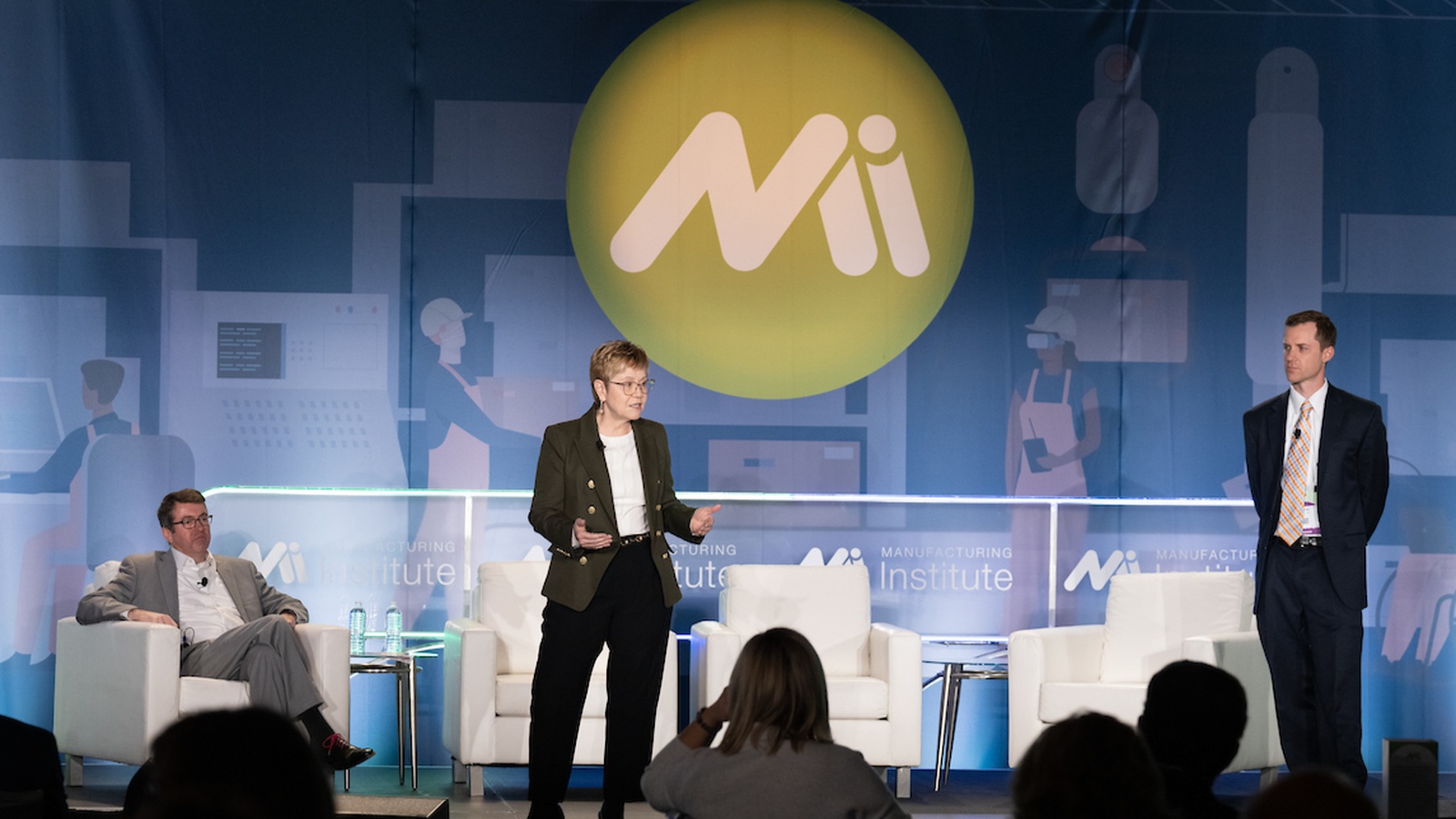
The skills gap is one of the biggest challenges facing manufacturers today—but what if there was a way to overcome it and fill jobs more effectively and easily? In fact, such a method exists, and it’s called “adaptive skills” development.
Timely topic: The Manufacturing Institute’s inaugural Workforce Summit in Cincinnati, Ohio, covered this topic last month, in a session led by two EY partners. Here’s what they had to say.
- “What are adaptive skills? It’s exactly as you would expect: they’re skills that help an individual learn and expand their capabilities to meet an ever-changing job function, business market [or] home environment,” EY Americas Business Consulting Leader Lisa Caldwell told the audience.
- Developing and leveraging these skills, which include communication and problem solving, helps companies retain a broader workforce, according to a recent joint EY–MI study that built on earlier research from EY and Oxford Said Business School, Caldwell said.
- This is particularly important today, as the U.S. workforce could have a shortage of 2.1 million manufacturing jobs by 2030 if the skills gap is not addressed, according to a joint Deloitte–MI study cited by Caldwell.
Manufacturing-specific skills: In their study, the EY and MI identified three specific adaptive skills “that were highly relevant to the manufacturing industry,” said EY People Advisory Services Partner Stephen Fuller during the session.
- Root-cause analysis: The ability “to understand what the root of a problem is, what the data needed to make a decision is,” as Fuller put it.
- Systems thinking: It’s “all about … asking questions. ‘Who does this? Where does this go? How does this work? When does XYZ occur?’”
- Creative reasoning: The key here is the ability to consider problems from unusual perspectives, said Fuller.
Lessons learned: Caldwell shared some of the major study takeaways that manufacturers can use.
- Create an adaptive culture: “[B]uild a culture that … empowers, a culture that wants collaboration, a culture that encourages and recognizes people who speak up, who bring forward ideas.”
- Parlay adaptive skills into new career paths: “If we build career paths and we define the skills and the capabilities that are needed for those career paths, focusing on adaptive skills as much as the technical skills, I think we have something that could really attract people to want to not only come but stay in manufacturing.”
- Invest in individualized learning: This can include rotating jobs, mentoring, shadowing programs and leveraging technology to create experiential learning for employees, said Caldwell.
- Add adaptive skills to your hiring strategy: “It’s really important that we have classroom training and virtual training that isn’t just slides up on a screen, but is very immersive for people and lets them actually feel and experience … what we’re trying to teach them.”
The last word: Ultimately, closing the skills gap “all starts with skills and infusing adaptive skills into your role profiles,” Fuller said. “[Use] it as a way to connect people to learning experiences that are meaningful for them. That’s ultimately the formula for success.”
Building the Future Workforce at Rockwell’s Automation Fair
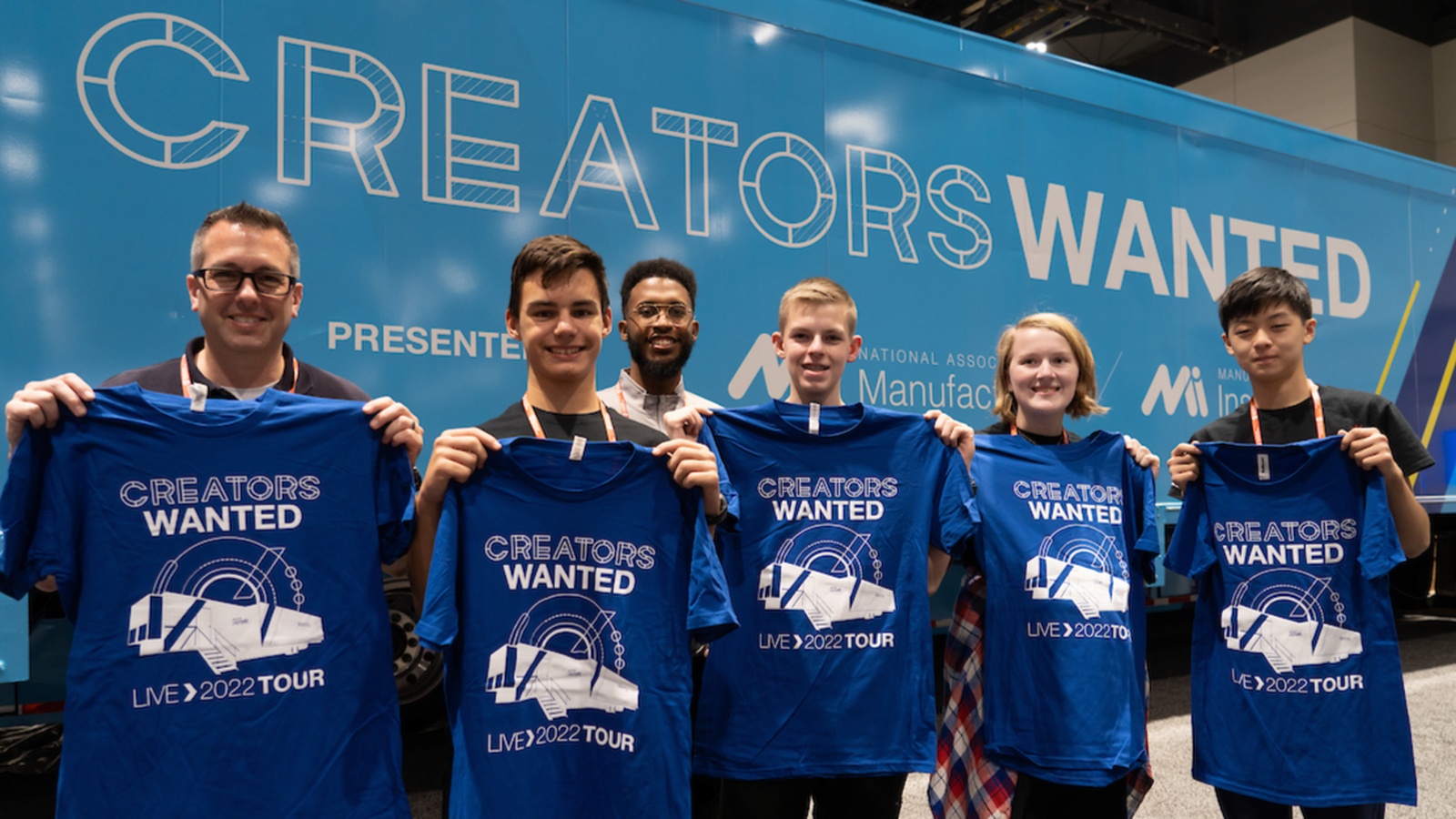
Automation isn’t just changing the manufacturing industry; it’s enabling human-centric progress in tackling the industry’s workforce crisis.
In action: As part of the Automation Fair in Chicago last week, more than 15,000 attendees got to see how manufacturers—and companies like Rockwell Automation—are providing solutions to the shortage, which could reach 2.1 million unfilled jobs by 2030, according to research from the Manufacturing Institute (the workforce development and education partner of the NAM) and Deloitte.
- Rockwell Automation brought the Creators Wanted Tour, a project of the NAM and the MI, to its Automation Fair, giving students, parents, educators and manufacturers the chance to see firsthand how digital transformation and new technologies are supporting careers and opportunities in modern manufacturing.
- The tour’s much-heralded immersive experience, along with displays and programs featuring experts from the MI and the Manufacturing Leadership Council (the digital transformation division of the NAM), gave attendees insight into the pathways and support available in the industry.
- FactoryFix, the official recruiting partner of Creators Wanted, was also on hand to showcase its manufacturing talent platform for job seekers—and manufacturers searching for a one-stop recruiting solution.
Changing perceptions: Creators Wanted aims to shrink the workforce gap by dispelling myths about automation and attracting the next generation to manufacturing jobs. It’s seeing impressive success, MI President Carolyn Lee said during a session at the event.
- “Today 40% of parents have a positive perception of manufacturing,” Lee said, citing a recent joint Deloitte–MI study. “And what we’re finding is that parents see these are durable careers with great possibility and opportunity, and they’re encouraging their children to consider them.”
Digital help: “Digital is going to help manufacturers deal with their workforce issues because it’s going to not only help change the perception of the industry, but create new jobs going forward, particularly in math-intensive areas like data analytics and artificial intelligence,” said MLC Vice President and Executive Director David Brousell.
- Brousell cited the MLC’s “Manufacturing in 2030 Project,” saying, “We have to think about digital transformation as human-centric digital transformation—because we’ve got to bring the technology and the people together simultaneously to have an effective transformation.”
Impressive results: Since it began just more than a year ago, the Creators Wanted Tour has seen more than 8,000 students pass through its immersive mobile experience, where more than 75% of attendees leave with a significantly improved view of manufacturing.
- More than 510,000 students and career mentors have also signed up to learn more about modern manufacturing careers.
- Creators Wanted has recruited successfully both mentors and mentees for the mentorship program of Women MAKE America, an MI initiative that aims to close the gender gap in manufacturing.
- The Automation Fair offered more than 150 interactive sessions on the newest industrial solutions and best practices, and more than 200 companies exhibited across 200,000 square feet at Chicago’s McCormick Place.
Media mentions: The fair and Creators Wanted’s presence drew a slew of media coverage, including from “Morning in America” with Adrienne Bankert, “The John Howell Show” on WLS-AM, Univision Chicago and suburban Chicago’s Daily Herald.
- In addition, the Daily Line published an op-ed on the future of manufacturing by NAM President and CEO Jay Timmons and Rockwell Automation Chairman and CEO and NAM Executive Committee member Blake Moret.
The last word: “As the world’s largest company dedicated to industrial automation and digital transformation, Rockwell is always looking toward the future of manufacturing,” Moret said. “Campaigns like Creators Wanted are critical to recruiting the best future talent to create a thriving workforce.”
Caterpillar Foundation Helps Veterans Find Manufacturing Careers
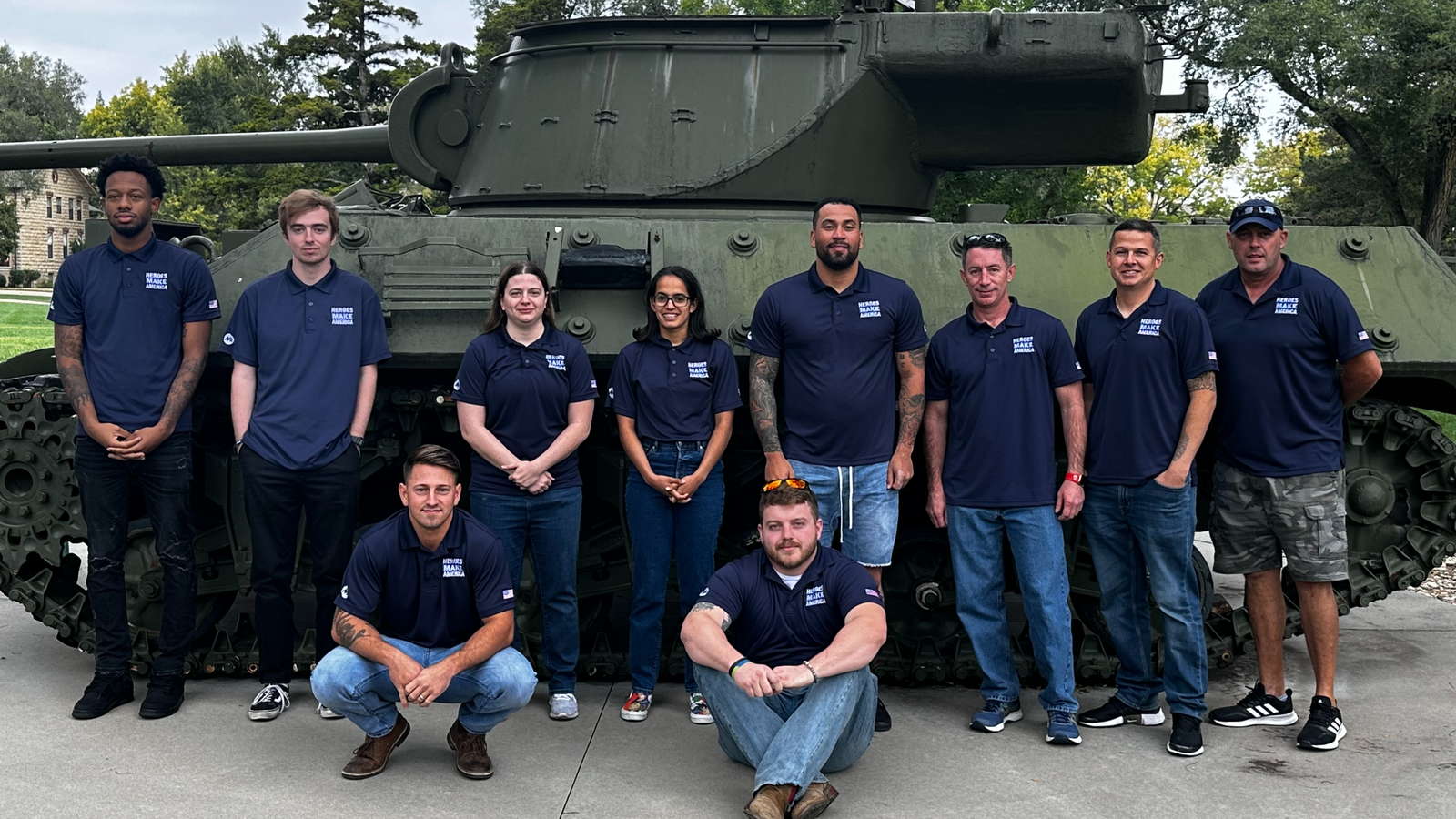
On Veterans Day, we honor the service members who safeguard our country, many of whom will go on to contribute their skills and experiences to civilian industries. Manufacturing is one beneficiary, with many veterans finding that the high-tech, mission-focused industry is an excellent home for their talents.
But how do transitioning service members and veterans find their new career paths? The Caterpillar Foundation is helping America’s heroes become tomorrow’s manufacturing leaders through its support of the Manufacturing Institute’s Heroes MAKE America initiative.
HMA provides integrated certification and career-readiness training in partnership with local community colleges to prepare transitioning service members, veterans, National Guard members, reservists and military spouses for rewarding careers in the manufacturing and supply chain industries.
Virtual training: The Caterpillar Foundation’s support began in 2021 and has helped HMA develop and launch its first 100% virtual training offering in partnership with Texas State Technical College—an exciting option for individuals across the country who might not be able to attend an in-person course.
- The program uses innovative solutions like virtual reality technology, provided by Transfr VR, in order to add a “hands-on” aspect to the students’ training for their Production Technician and OSHA 10 certifications.
- “Heroes MAKE America was great,” said Benjamin Novak, a graduate of Heroes MAKE America’s virtual training program. “The virtual self-paced program allowed me to balance class, transitioning and family life. Getting an opportunity to connect and speak with companies directly was a huge opportunity as well.”
New programs: Additionally, thanks to the foundation’s grant, Heroes MAKE America launched two new in-person training paths: a Mechatronics training program at Fort Hood, Texas, also in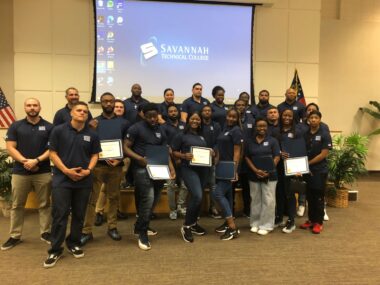 partnership with Texas State Technical College, and a Certified Logistics Technician training program at Fort Stewart/Hunter Army Airfield, Georgia, in partnership with Savannah Technical College.
partnership with Texas State Technical College, and a Certified Logistics Technician training program at Fort Stewart/Hunter Army Airfield, Georgia, in partnership with Savannah Technical College.
- Together, the three new training offerings (the two mentioned above and the virtual option) have graduated 133 participants as of November 2022, with another 40 participants expected to graduate in December.
- “Heroes MAKE America is a great program that wants to see veterans succeed,” said Anna Rabago, a graduate of the Mechatronics training at Fort Hood, Texas. “They helped mold me into a great candidate for manufacturing while earning seven manufacturing certifications. The instructors are subject-matter experts in their field and are willing to work early or late evenings to benefit the soldiers.”
An impressive year: The HMA program is on track to graduate 303 members of the military community across all 6 training sites in 2022, bringing the total number of graduates since the 2018 inception of HMA to 957. The training sites include Fort Hood, Texas; Fort Stewart/Hunter Army Airfield, Georgia; Fort Riley, Kansas; Fort Campbell, Kentucky; Fort Bragg, North Carolina; and the 100% virtual option.
The last word: “HMA provided me with all the tools that I needed to thrive as a civilian,” said Tillman Harris, a graduate of the Production Technician training at Fort Bragg, North Carolina. “They provided industry training, résumé assistance, interview prep and much more. Trust in yourself and have confidence in everything you do. HMA is a program that cares about us and wants us to succeed.”
Learn more: Find out more about Heroes MAKE America here.
MI President Carolyn Lee Talks Workforce Development
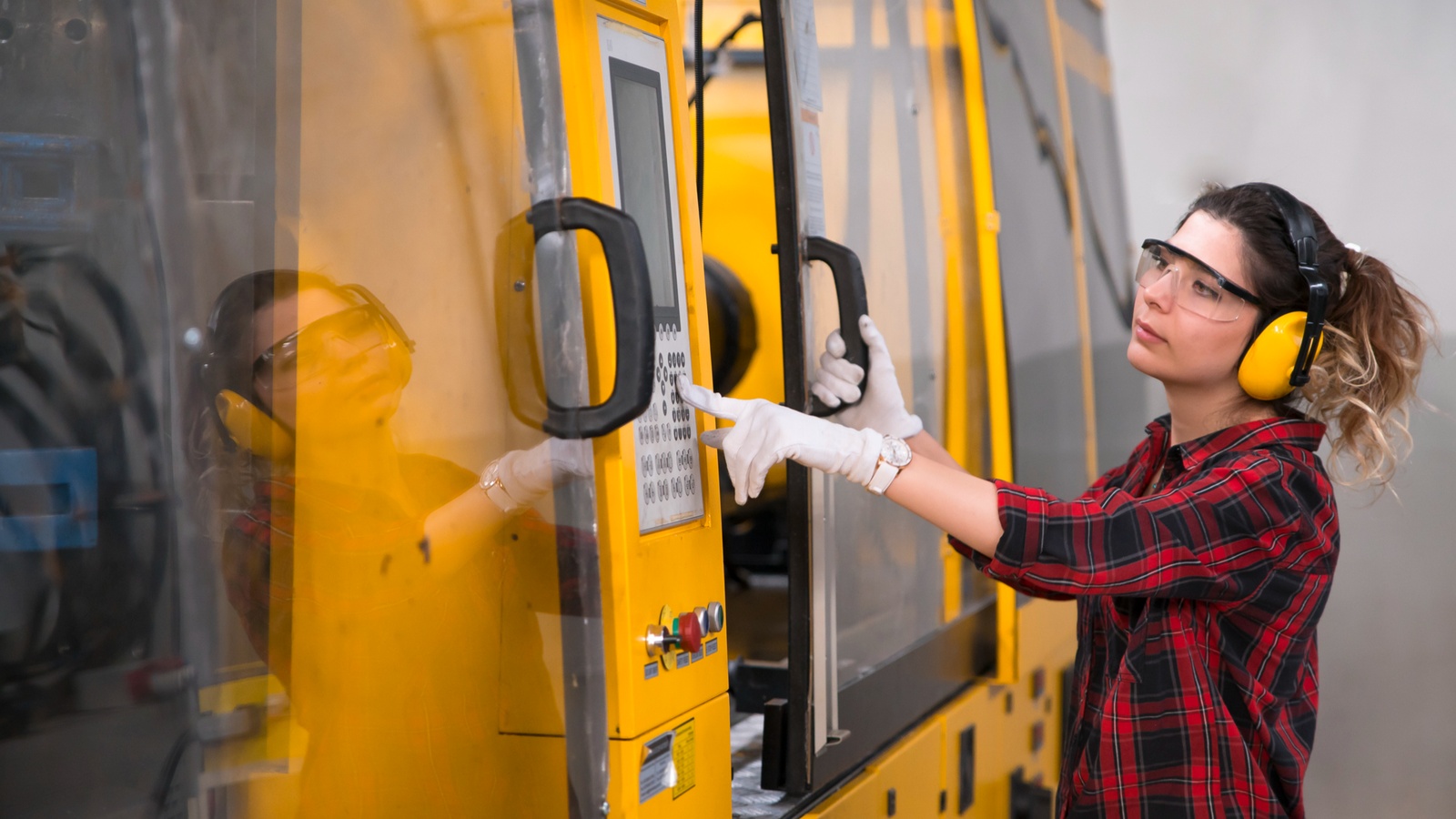
Manufacturers continue to face an alarming workforce shortage—which could result in 2.1 million unfilled jobs by 2030, according to a study by The Manufacturing Institute and Deloitte.
The MI—the workforce development and education partner of the NAM—is working hard to fill that gap. MI President Carolyn Lee spoke at the Made in Connecticut: 2022 Manufacturing Summit last week about how manufacturers are taking on this critical issue and what lies ahead.
The challenge: “One of the biggest long-term issues our industry is confronting is the perception problem,” said Lee. “Many Americans—usually parents—cling to the belief that the manufacturing industry is not a place where people can find satisfying, well-paying lifelong careers. … Our industry needs to overcome this perception and grow the supply of young workers.”
Making progress: “That brings me back to good news: perceptions are changing,” said Lee. “Thanks to movements like MFG Day, and campaigns like the National Association of Manufacturers and The Manufacturing Institute’s ‘Creators Wanted’ campaign, which is touring the country right now, we are moving the needle.”
- “We’re showcasing modern manufacturing as we know it to be: exciting, rewarding, clean and high-tech,” said Lee. “Thanks to these efforts, the positive perception of manufacturing among adults in the past few years has grown from 27% to 40%.”
Promoting programs: Lee spoke about a range of programs offered by the MI that are designed to help build an expansive and inclusive manufacturing workforce. These programs include:
- Women MAKE America, formerly known as the STEP Ahead program, which supports women in manufacturing;
- Heroes MAKE America, which eases the transition to civilian careers for veterans and other members of the military community; and
- FAME, which was originally founded by Toyota before transitioning over to the MI in 2019, and which offers an “earn and learn” apprenticeship experience.
Pushing policy: Lee noted the importance of ensuring that government policy is aligned with the needs and realities of the manufacturing industry. She also highlighted elements of “Competing to Win”—the NAM’s policy blueprint for bolstering manufacturers’ competitiveness. Proposed policies include:
- Reorienting the education system and its funding around a skills and employer-involved model;
- Updating federal tax policy to encourage and reward companies that invest in upskilling their employees; and
- More federal investments in apprenticeship models.
The last word: “Our industry’s strength and competitiveness will be determined by the strength of our workforce,” said Lee. “After all, they are the creators who pioneer and produce lifechanging electronics or lifesaving medicines. They are innovating and building the machines that transform human mobility, improve quality of life or bolster our national defense.”
Learn more: Find out more about the MI’s vital work here.
Creators Wanted Moves the Needle in Decatur
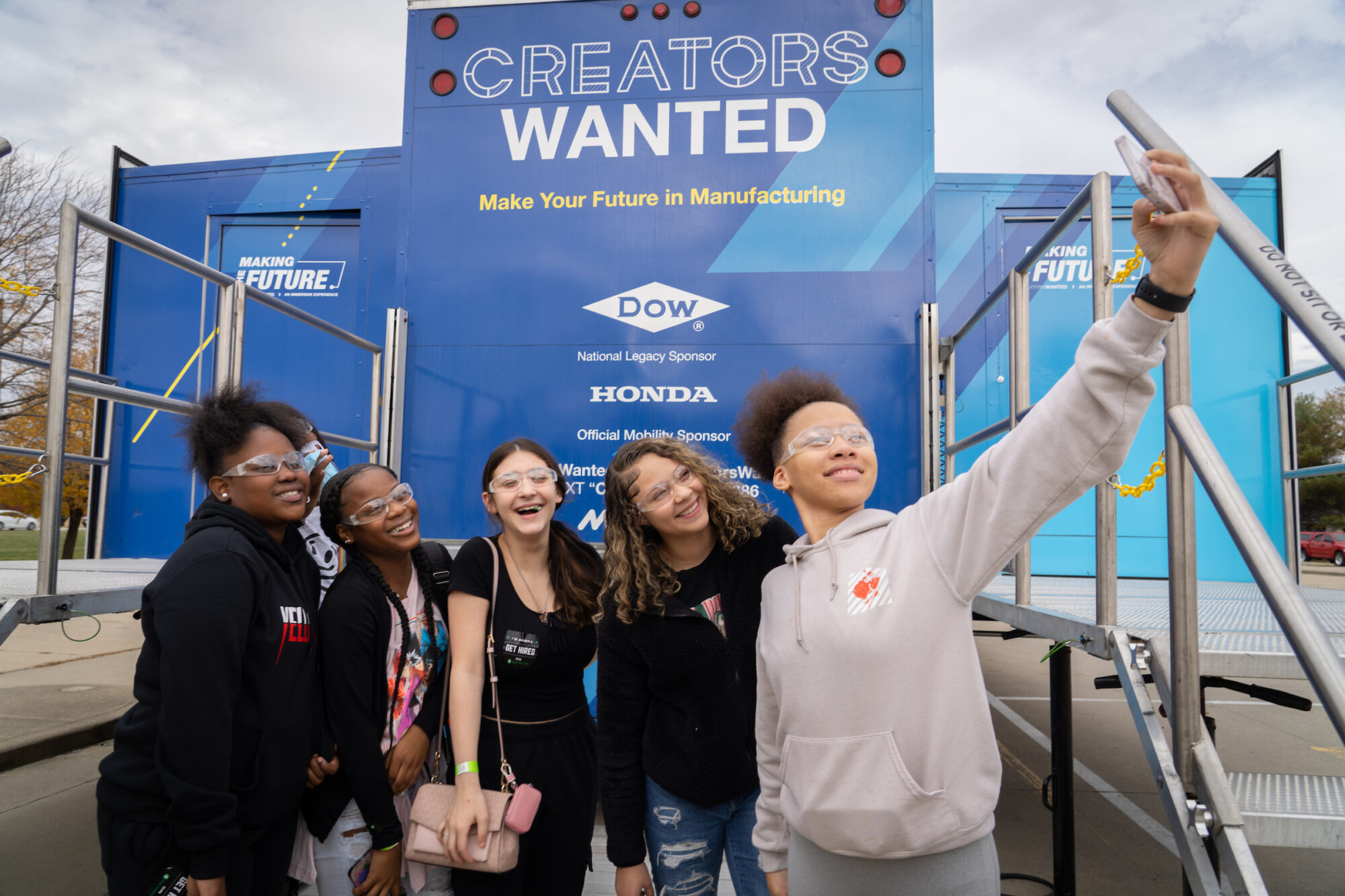
While participants were having fun at this week’s Creators Wanted stop in Decatur, Illinois, the nationwide tour and its mobile experience were doing something, too: moving the needle on people’s perceptions of modern manufacturing.
What went on: Over the course of three days, more than 800 students from 13 area middle schools, high schools and community colleges poured into Richland Community College to learn about manufacturing careers. Also present were many educators and parents.
- Attendees “raced to the future” in the Creators Wanted mobile experience, solving various manufacturing-related challenges as they wound through the escape room.
- They heard panel talks from manufacturing leaders and team members and learned about some of the industry’s many perks, including great wages, flexible schedules, upward mobility, chances to earn and learn and more.
- Interactive activities, set up and run by manufacturers and the campaign’s recruiting partner, FactoryFix, were designed to garner interest—and display some of the real work done every day in modern manufacturing.
- This included virtual-reality paint and assembly training from Creators Wanted host sponsor Caterpillar, as well as a hazard-awareness simulator, a drink-making station and a laser-system exhibit from host sponsor ADM. Richland Community College took students on a tour through its state-of-the-art lab.
Generation inspired: Manufacturing leaders at ADM, Caterpillar and the Illinois Manufacturers’ Association, which together brought the tour to Decatur, got the chance to galvanize crowds.
- Said IMA President and CEO Mark Denzler: “Manufacturing makes the world a better place to live every day. Some of you are going to find the next cure for a disease. You’re going to build the next robot.”
- “For anyone who really is looking for a career that you can get into that is good-paying, that will provide you an opportunity to progress, consider manufacturing,” Caterpillar Group President of Resource Industries (and NAM Executive Committee member) Denise Johnson told the crowd.
- Following the event, students were indeed inspired. “It kind of changed my mind on what I want to do in the future,” one student
- “It was amazing,” said another. “I’d think about doing this for a career.”
Shoring up the shortage: The lack of skilled workers has been a pain point for manufacturers for several years now—and it’s a problem Creators Wanted aims to fix.
- “Programs like Creators Wanted are crucial in narrowing the workforce shortage in manufacturing and also showcasing the many opportunities within the manufacturing industry,” said ADM Senior Vice President of Global Operations and NAM board member Veronica Braker.
The impact: The tour stop made a splash in regional media, garnering overwhelmingly positive broadcast coverage and print mentions and placements (see here and here).
Meeting people where they are: “How do you get more young people interested in the field [of manufacturing]?” 25 News WEEK-TV anchor Erin Brown asked in a segment for the Peoria, Illinois, news station. “The answer could be more hands-on experiences with businesses like Caterpillar and ADM.”
Phoenix Closures Invests in Diversity and Inclusion
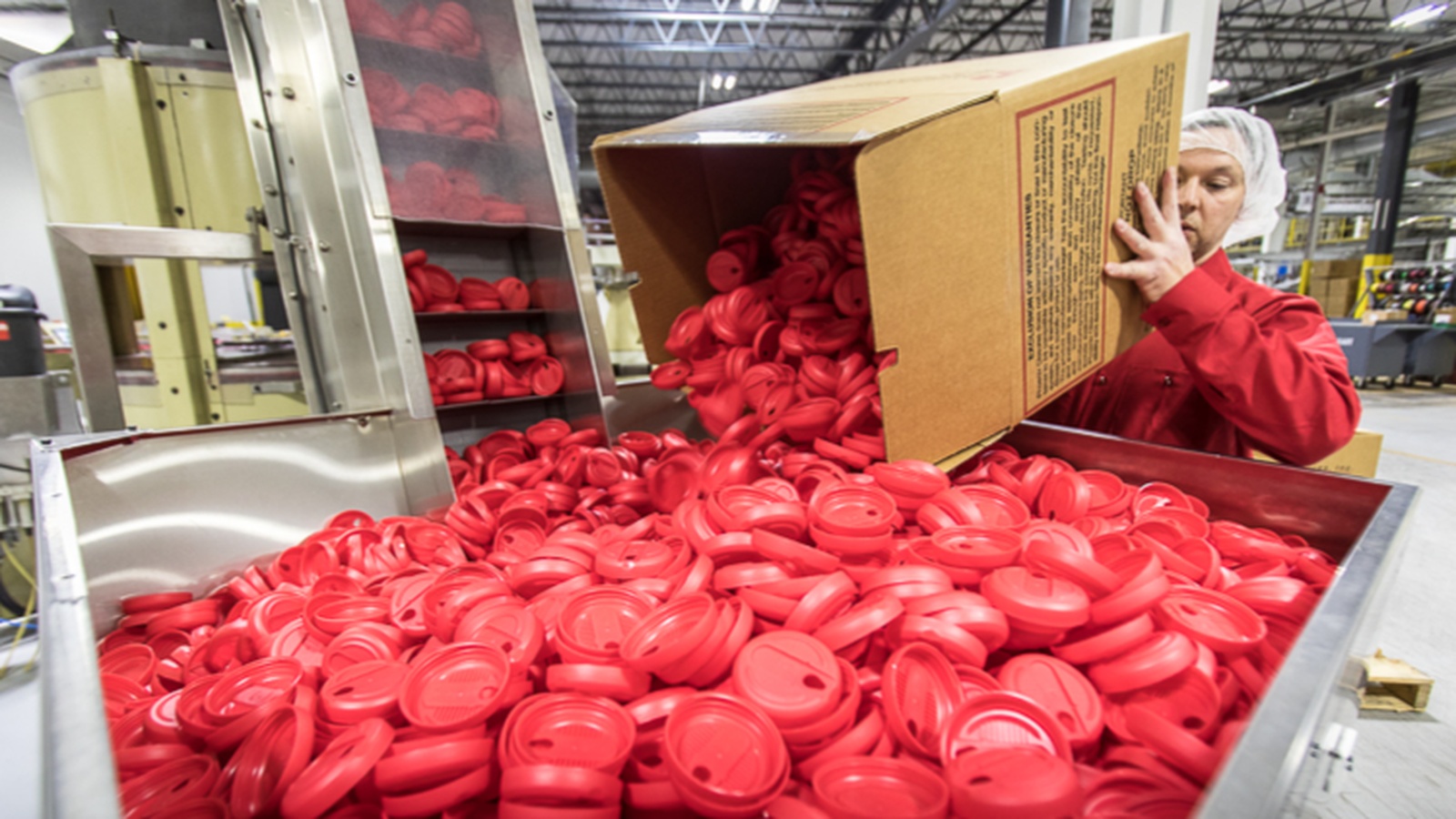
Manufacturers come from many different communities and backgrounds—and Phoenix Closures, a sixth-generation, family-owned business that makes packaging and closures, wants to make sure that all of them feel welcome in the industry. In the past few years, the company has created a D&I initiative that ensures their employees feel included in and excited about the place where they work.
Getting the ball rolling: The company began by installing a leader to oversee their D&I efforts and combine programming and support into one place. Vice President of Quality and Corporate Social Responsibility Meena Banasiak—a 2020 honoree at the Women MAKE Awards, formerly known as the STEP Ahead Awards—sees her role not only as that of a leader, but as proof of Phoenix’s commitment.
- “I’m part of our progress in terms of D&I at Phoenix,” said Banasiak. “This position I am in was created in order to have someone in the role to establish a framework for corporate social responsibility. This position had never previously existed.”
- “We knew as a business that we were in many ways doing a lot of things that would fall within a D&I program, but without that clear purpose and intention and definitive resources put behind it.”
- “So, in a very visible and important way, I had the opportunity to be in a position of leadership and join the executive staff as a woman of color and set the course for the nature of this work that we
’ve been pursuing.”
Developing programs: The company has created and implemented a range of initiatives that allow employees to connect and contribute.
CSR committee: Phoenix developed an employee resource group that is focused on corporate social responsibility and includes representation from all the company’s operating locations. Employees are encouraged to voice their ideas on the types of programs that could be offered to the workforce, and the group offers tools and resources to help members implement programs at their respective sites.
- “It’s great to have a way to give people that voice, to make the work environment something
 that enables us to feel more included,” said Banasiak. “Yes, we’re here to do good work, but we might just be able to have fun while we’re doing it! We want our employees to feel comfortable bringing their whole selves to work if they want to and develop more profound relationships in the process.”
that enables us to feel more included,” said Banasiak. “Yes, we’re here to do good work, but we might just be able to have fun while we’re doing it! We want our employees to feel comfortable bringing their whole selves to work if they want to and develop more profound relationships in the process.”
Parental leave: The company has expanded its parental leave benefits. Today, all full-time employees are eligible for the program, and the benefit applies to the non-birthing parent as well—including in cases of adoption.
- “There are people who have been able to take advantage of it right away—and just hearing their personal story, and their sense of relief knowing they have this support from their company—it’s unfettered relief,” said Banasiak. “It goes a very long way toward cementing the relationship between employer and employee, when you feel like your employer is invested in you.”
Volunteer time off: Phoenix’s full-time employees are encouraged to take up to eight hours of paid time off per calendar year to volunteer with the charitable organization of their choice—either individually, or as part of a team.
- “There have been a few different events where a group of employees have gone together, so it simultaneously serves as a teambuilding exercise with a broader impact,” said Banasiak. “At the same time, we get to share the stories of these experiences and celebrate those organizations that our employees find meaningful to them. Excitement breeds further excitement.”
Pledge for Action: Phoenix was a signatory of the NAM’s Pledge for Action, which committed the manufacturing industry to taking 50,000 tangible actions to increase equity and parity for underrepresented communities, creating 300,000 pathways to job opportunities for Black people and all people of color, and reflecting the diversity of the overall U.S. workforce by 2030.
Starting small: According to Banasiak, it’s important to be sensitive to needs across the entire company, but also to create small forums where employees can feel comfortable discussing issues. By empowering employees to come forward with ideas, a company can unleash the creativity, energy and enthusiasm of a diverse workforce.
Building the habit: “At first you might be in a place that feels more performative rather than substantive, but it’s still a legitimate starting point,” said Banasiak.
- “We never before made an intentional effort to acknowledge Hispanic Heritage Month or Black History Month. By now, our employees are creating and hosting their own events—but before that, our first step was literally a single email to the organization.”
- “I’d argue that first step is every bit as necessary and valid on this journey. Just making that conscious effort—that’s going to be meaningful to someone. It’s necessary to build that habit in small ways to create an environment where ideas start to flow. The motivation builds upon itself, but you have to start somewhere.”
The bottom line: “Results are not instantaneous or something that one person can achieve,” said Banasiak. “It’s about slowly shifting the narrative.”
NAM Board Leaders Headline Creators Wanted Kickoff in Decatur
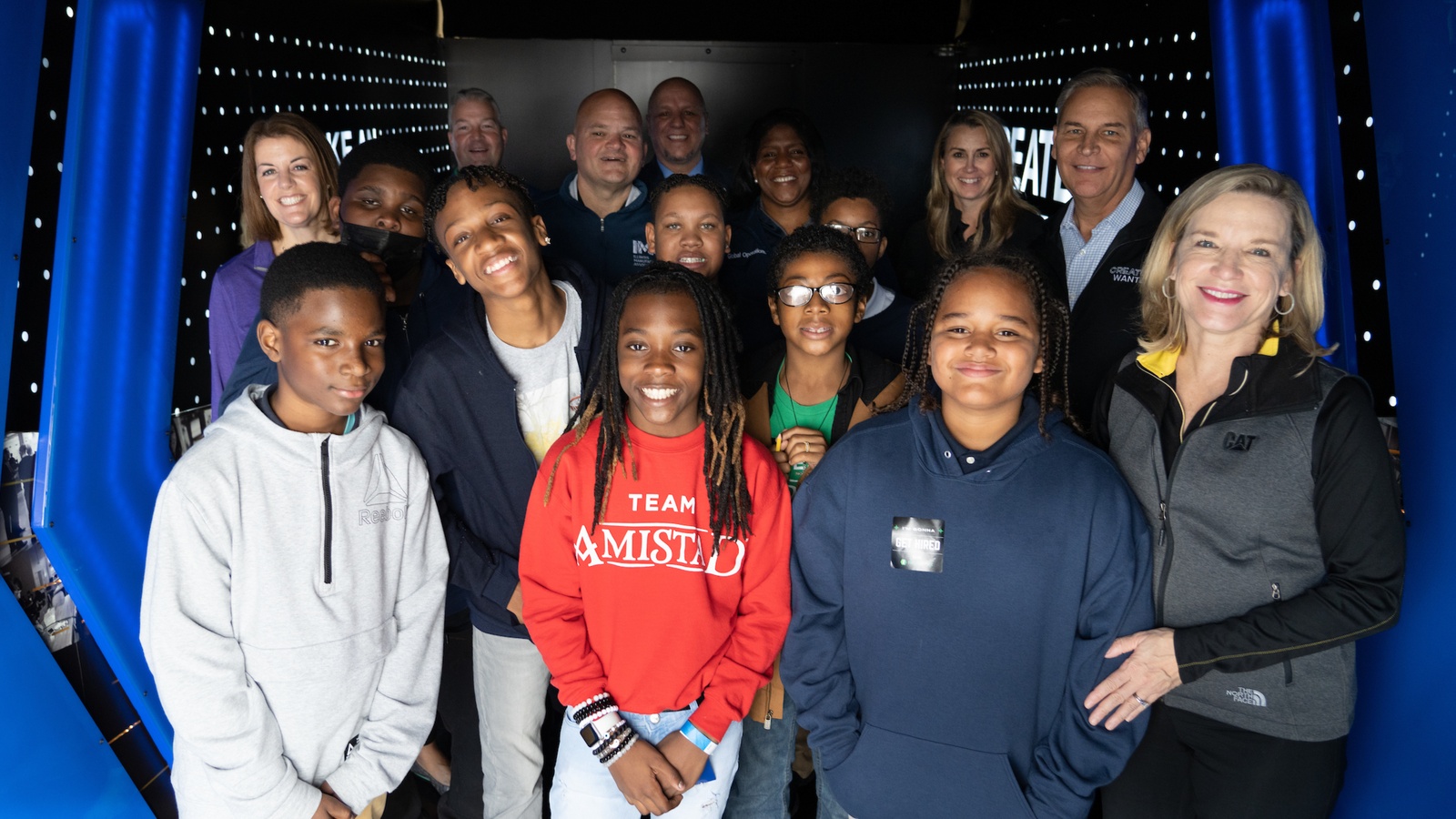
Two of manufacturing’s top executives took centerstage yesterday as a part of the industry’s largest perception campaign to build the workforce of the future—by helping educators, parents and other career mentors coach students on their career journeys.
- Caterpillar Group President of Resource Industries (and NAM Executive Committee member) Denise Johnson and ADM Senior Vice President of Global Operations (and NAM board member) Veronica Braker joined NAM President and CEO Jay Timmons, Manufacturing Institute President Carolyn Lee, Illinois Manufacturers’ Association President and CEO Mark Denzler and other notable state, community and education leaders to kick off the Decatur, Illinois, stop of the Creators Wanted Tour at Richland Community College.
- More than 120 students from American Dreamer STEM Academy attended the kickoff event. (More than 800 students are expected over the tour stop’s three days.) There they heard manufacturing leaders’ perspectives before exploring the various exhibits and activations showcasing the many opportunities in modern manufacturing.
Power of visibility: “Not everyone has a perspective or has heard from someone who looks like me or is from the same place,” said Braker, who is also on the global nutrition company’s Executive Council. “But together, we can change one event at a time.”
- “While pursuing my degree in chemical engineering, I interned with several manufacturing companies. … For me, manufacturing was always an attractive choice due to the fast pace, the energy, as well as the opportunity to solve problems while working as a part of a team, making a real impact on people’s lives,” emphasized Braker.
- On the rewards of her own manufacturing career, spanning more than a quarter of a century in operations leadership, Braker pointed out, “I’ve made lifelong friends. I’ve been exposed to innovative technologies that will change the way that people and generations live forever.”
Teamwork and growth drove Johnson’s path into manufacturing—and an ascent to the upper echelons of the world’s leading manufacturer of construction and mining equipment.
- “I was working in the design and engineering arena, and I was really wanting to move into manufacturing because I thought it would give me an opportunity to learn some new skills and be able to … work with teams and people to a larger degree.”
- In a panel conversation, Johnson, along with Tara Tolly, operations director of ADM’s Decatur manufacturing complex, highlighted more of the advantages of manufacturing careers, including great pay, diverse career paths and roles, upward mobility, variability of days, earn-and-learn options and chances to lead and develop transferable skills.
Answering the call: “It’s events like Creators Wanted where we need to be present and active for our students and encouraging them to start early and get engaged with opportunities that offer rich and fulfilling experiences for them,” said Braker.
- Braker and Johnson were instrumental in arranging the Creators Wanted Tour appearance in Decatur, in partnership with the Illinois Manufacturers’ Association, mobilizing not just financial backing but also team and community support to help excite the next generation of creators.
Why it matters: “Fifty percent of Macon County’s economy [where Decatur is located] comes from manufacturing … the single highest share of any county in Illinois,” said Denzler. “Programs like Creators Wanted are crucial for making significant progress in narrowing the workforce shortage … in manufacturing,” added Braker.
Beyond the campus: WAND-TV, the local NBC affiliate, covered the kickoff, and Timmons and Denzler joined Decatur’s top morning radio talk show, “Byers & Co.,” to amplify the Creators Wanted message. More than 500,000 students and career mentors have signed up to date through the Creators Wanted Tour to learn more about modern manufacturing careers.
Creators Wanted “Lends a Helping Hand” in S.C.
Last week was a milestone for the Creators Wanted Tour—it marked the first time the nationwide initiative returned to a community and got to see how perceptions of manufacturing had changed since its first visit.
Welcome back: The Creators Wanted Tour, a joint venture of the NAM and its workforce development and education partner, The Manufacturing Institute, returned to host and champion sponsor Nephron Pharmaceuticals Corporation in West Columbia, South Carolina, in the 11th stop of the roadshow, which took place Oct. 4–7.
Happy MFG Day! On MFG Day, Oct. 7, Creators Wanted campaign co-chair Lou Kennedy, president, CEO and owner of Nephron Pharmaceuticals Corporation, and her team hosted the tour stop’s premier event at its new Nephron Nitrile Glove Factory. The 426,000-square-foot facility is scheduled to open next month and will produce nitrile gloves used in hospitals and sterile rooms globally.
- The protective-glove shortage in the U.S. during the pandemic inspired Kennedy to build the factory, which is set to produce 2 million gloves a year at full capacity.
- South Carolina legislators from both sides of the political aisle were on hand for a tour of the site. House Democratic Majority Whip James Clyburn and Republican Reps. Joe Wilson and Jeff Duncan joined hundreds of local students, educators, community leaders and manufacturers to view and learn more about the campaign and its resources.
Ready for the “boom”: “There is a manufacturing boom taking place all over the country,” Majority Whip Clyburn said. “We’ve got to focus on getting these young people prepared” for manufacturing careers.
- As Rep. Wilson said, “The opportunities for manufacturing just can’t be better.”
- “401(k), great salary—average wage of 75 to 80K—clean and beautiful working conditions and hard work with a lot of fun,” Kennedy said of jobs at Nephron, while extolling opportunities at modern manufacturers across the state and in nearby communities.
- Major Creators Wanted supporters Honda and Trane Technologies also have operations in the Palmetto State, and several other campaign sponsors, including Chroma Color Corporation, are within a short distance of West Columbia.
More career guidance: Students seeking tailored advice about their professional futures got it from representatives of FactoryFix, official recruiting partner of Creators Wanted, who were on hand to meet and coach job seekers.
- South Carolina Chamber of Commerce President and CEO Bob Morgan, whose organization is a tour partner, was on site with his team to give students information on manufacturing opportunities in South Carolina.
- On Friday, Creators Wanted sponsor Autos Drive America had an exhibit showing attendees the types of vehicles being manufactured in South Carolina.
Women in manufacturing: During a “fireside chat” panel on the tour stop, Kennedy was joined by Autos Drive America President and CEO Jennifer Safavian and MI President Carolyn Lee to discuss the importance of advancing more women in manufacturing.
- “Growing up here in the deep south 20, 30 years ago, we were supposed to be teachers or … nurses; we weren’t supposed to be pharma CEOs,” Kennedy said. “And so, my goal is to help every young lady be what she wants to be, even if it’s the nontraditional career path. … If you want to be a super-genius chemist, you can do that. If you want to be a super-genius engineer, you can do that.”
- Echoed Safavian, “I think the message [of Creators Wanted] is, ‘Don’t be afraid to ask questions. Don’t be afraid to try something. For women especially, this is a terrific opportunity. … A lot of people think manufacturing is dark, dirty, dangerous. It is not. … it is the complete opposite.”
Calling all veterans: Modern manufacturing is also a natural fit for those who have been in the military, speakers told the audience during another panel discussion.
- “I started at Nephron as a senior system analyst, and throughout my career everything that I was faced with at Nephron I’d already seen in the military,” said Air Force veteran Eric Jackson, now a senior IT security analyst at Nephron. “So, I think the [military] training … is what prepared me for this job.”
The reach: The South Columbia 2022 tour stop, made possible by additional support from Dow, Honda and Nephron Pharmaceuticals, was a record breaker.
- More than 700 students from 13 schools—most located in traditionally underrepresented communities—participated in the tour stop’s events. Last year, those numbers were 500 and seven, respectively.
- This year’s West Columbia email signups—people wishing to learn more about manufacturing careers—brought Creators Wanted’s total signups to more than 520,000.
The last word: The tour stop may have been best summarized by one young student who attended the events. “Creators Wanted,” she said, “is a helping hand.”
